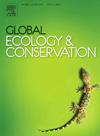利用物种种群结构协助管理和决策,打击入侵物种:大西洋蓝蟹的案例
IF 3.5
2区 环境科学与生态学
Q1 BIODIVERSITY CONSERVATION
引用次数: 0
摘要
蓝蟹(Rathbun,1896 年)是地中海的入侵物种,具有适应各种生境的卓越能力,因此对生物多样性和手工捕鱼活动产生了重大影响。目前,捕捞是控制入侵地点蓝蟹数量的一种措施。然而,有必要了解青蟹种群的时间结构(如生长、繁殖、性成熟),以确定需要实施控制措施的具体时期。考虑到该物种适应各种生境的能力,评估温度和盐度对种群结构的影响至关重要。在本研究中,我们对科西嘉岛(法国)两个泻湖中青蟹的种群结构进行了为期 12 个月的监测。通过这种方法,我们提供了有助于实施控制措施决策的新信息。尽管这两个泻湖地理位置相近,但青蟹种群却表现出差异,尤其是在性成熟方面。比古利亚的标本(雄性:16.16 厘米;雌性:16.79 厘米)比帕洛泻湖的标本(雄性:14.38 厘米;雌性:13.86 厘米)成熟得晚。季节性体型分布也显示出不同泻湖之间以及同一泻湖内雄性和雌性之间的差异。温度和盐度对雄性和雌性以及不同泻湖之间鳞甲宽度和湿重(此处称为生长率)之间的月度关系有显著影响。在比古利亚泻湖,温度越高,在较宽的盐度范围内(16-30 psu),生长率越大;对于雌性而言,环境窗口受到限制(温度:20-30°C;盐度 > 16 psu)。帕洛泻湖中的动态有所不同,雄蟹的高生长率窗口更为有限,而雌蟹的窗口更宽,在整个温度和盐度范围内都有高生长率。通过利用蓝蟹种群监测和环境参数,我们能够确定环境对蓝蟹种群结构的影响,从而确定有利于物种控制的时期。最有效的策略无疑是在雌蟹性成熟和交配之前消灭它们。就我们的情况而言,这需要在夏季和春季分别对比格利亚和帕罗进行密集控制。这些建议已转化为行动,将作为 "科西嘉岛打击蓝蟹计划(2024-2027 年)"的一部分加以实施。本文章由计算机程序翻译,如有差异,请以英文原文为准。
Using species population structure to assist in management and decision-making in the fight against invasive species: The case of the Atlantic blue crab Callinectes sapidus
The blue crab Rathbun, 1896 is an invasive species in the Mediterranean, with a remarkable ability to adapt to various habitats, and thereby having significant impacts on biodiversity and artisanal fishing activities. Currently, fishing is a measure being considered to control blue crab populations in invaded sites. However, it is necessary to understand the temporal structure of blue crab populations (e.g., growth, reproduction, sexual maturity) to determine specific periods when control measures need to be implemented. Considering the species' ability to adapt to various habitats, it is crucial to evaluate how temperature and salinity influence population structure. In this study, we present fishers-dependent monitoring on the temporal population structure of blue crabs in two lagoons in Corsica (France) over 12 months. Through this approach, we provide new information that can assist in decision-making for the implementation of control measures. Even though these two lagoons are geographically close, blue crab populations showed differences, particularly in terms of sexual maturity. Specimens from Biguglia mature later (males: 16.16 cm; females: 16.79 cm) than those in the Palo Lagoon (males: 14.38 cm; females: 13.86 cm). Seasonal size distribution also showed differences between the lagoons and within the same lagoon between males and females. Temperature and salinity had a significant effect on the monthly relationship between carapace width and wet weight (referred to here as growth rate) for males and females and between the lagoons. In the Biguglia Lagoon, the higher the temperature, the greater the growth rate over a wide salinity window (16–30 psu); for females, the environmental window was restricted (temperature: 20–30°C; salinities > 16 psu). The dynamics differed in the Palo Lagoon, with a more restricted high growth rate window for males, and females showed a much wider window, with high growth rates over the entire temperature and salinity range. By employing blue crab’s populations monitoring along with environmental parameters, we were able to determine how the environment influenced the blue crab’s population structure, thus identifying periods conducive to species control. The most effective strategy would undoubtedly be to eliminate females before their period of sexual maturity and copulation ensue. In our case, this would involve intensive control in summer for Biguglia and in spring for Palo. These recommendations have been translated into operations to be implemented as part of the "Territorial Plan for Combating the Blue Crab () in Corsica (2024–2027)".
求助全文
通过发布文献求助,成功后即可免费获取论文全文。
去求助
来源期刊

Global Ecology and Conservation
Agricultural and Biological Sciences-Ecology, Evolution, Behavior and Systematics
CiteScore
8.10
自引率
5.00%
发文量
346
审稿时长
83 days
期刊介绍:
Global Ecology and Conservation is a peer-reviewed, open-access journal covering all sub-disciplines of ecological and conservation science: from theory to practice, from molecules to ecosystems, from regional to global. The fields covered include: organismal, population, community, and ecosystem ecology; physiological, evolutionary, and behavioral ecology; and conservation science.
 求助内容:
求助内容: 应助结果提醒方式:
应助结果提醒方式:


